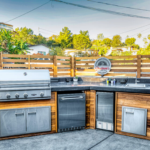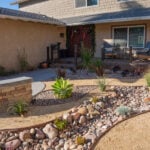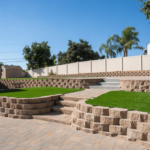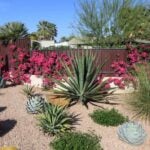Landscape design is an artful blend of natural and man-made elements that transforms outdoor spaces into captivating environments. At its core, this creative endeavor weaves together two fundamental components: hardscape and softscape. These elements form the backbone of every well-designed landscape, offering a harmonious interplay between structure and nature.
Within this canvas of design, hardscape and softscape emerge as the fundamental threads weaving intricate patterns of beauty and functionality. Each element holds its unique significance, sculpting not just spaces but immersive environments that beckon individuals to immerse themselves in the wonders of the outdoors. It’s a testament to the delicate equilibrium struck between the man-made and the organic, where every stone, plant, and architectural feature plays a role in orchestrating an enchanting narrative of outdoor living.
In this realm of landscape design, hardscape stands tall as the backbone, offering structure, delineation, and purpose to outdoor spaces. Simultaneously, softscape breathes life into these structured settings, painting vivid strokes of color, texture, and seasonal dynamism. Together, they form an inseparable duo, breathing vitality and character into every corner of a meticulously crafted landscape.
Hardscape and Softscape
Hardscape embodies the non-living, structural elements within a landscape design. It encompasses various man-made features such as paths, patios, walls, decks, pergolas, and other architectural structures. These components provide framework, delineation, and functionality to outdoor spaces. Materials like concrete, stone, wood, metal, and bricks are commonly used to craft hardscape elements, each contributing its unique texture, color, and form.
On the other hand, softscape refers to the living, horticultural elements comprising vegetation, soil, and other organic elements. This includes plants, trees, shrubs, flowers, grass, and any other greenery that enhances the natural beauty of the landscape. Softscape elements add life, texture, color, and seasonal variations, breathing vitality and dynamism into the outdoor space.
Structure and Functionality
Hardscape elements form the backbone of a well-designed landscape. They define spaces, create visual interest, and provide functional areas for various activities.
- Pathways and Patios: Pathways made of pavers or natural stones guide movement within the landscape, creating a sense of direction and flow. Patios serve as outdoor living spaces, offering areas for relaxation, dining, or entertainment.
- Retaining Walls and Fences: Retaining walls add dimension to the terrain, preventing soil erosion and creating leveled areas for gardens or seating. Fences delineate boundaries, offer privacy, and contribute to the landscape‘s aesthetic appeal.
- Water Features and Fire Pits: Water elements like fountains, ponds, or waterfalls add tranquility and auditory appeal. Fire pits or fireplaces introduce warmth and create focal points, inviting gatherings during colder months.
- Structures and Sculptures: Architectural elements like pergolas, gazebos, or arbors provide vertical interest and can be adorned with climbing plants, adding a touch of greenery. Sculptures or artistic installations act as focal points, infusing personality into the landscape.
Nature’s Palette and Vitality
Softscape elements infuse landscapes with natural beauty, offering a constantly evolving canvas that changes with the seasons and plant growth.
- Plants and Trees: Trees and plants of various sizes, shapes, textures, and colors breathe life into the landscape. Evergreens provide year-round foliage, while deciduous trees offer seasonal color changes. Groundcovers and grasses add texture and fill spaces between hardscape elements.
- Flowerbeds and Gardens: Flowerbeds bursting with seasonal blooms create vibrant focal points and add splashes of color. Vegetable or herb gardens not only provide fresh produce but also contribute to the landscape‘s diversity.
- Lawns and Turf: Lawns or turf areas serve as open spaces for recreation, offering a green carpet for relaxation, play, and outdoor activities.
- Soil and Mulch: Healthy soil forms the foundation for a thriving landscape, supporting plant growth. Mulch helps retain moisture, suppress weeds, and enrich the soil while providing a uniform appearance to garden beds.
Achieving Harmony
The success of a landscape design lies in the synergy between hardscape and softscape elements. Striking a balance between these components is crucial to creating a cohesive and visually appealing outdoor space.
- Unity and Cohesion: Hardscape elements should complement the surrounding softscape, creating a seamless transition between the man-made and natural elements. Consistent design themes, materials, or color palettes tie the elements together, fostering a unified aesthetic.
- Functionality and Aesthetics: While functionality is key in hardscape design, it should not overshadow aesthetics. Softscape elements soften the hardscape features, adding natural beauty and enhancing the visual appeal of functional structures.
- Scale and Proportion: Balancing the scale and proportion of hardscape and softscape elements is essential. Oversized hardscape features can overpower the landscape, while an abundance of softscape might appear unkempt. Finding equilibrium creates a visually pleasing environment.
- Seasonal Considerations: Softscape elements change with the seasons, offering an ever-evolving landscape. Designing with seasonal variations in mind ensures year-round interest, with blooming flowers, changing foliage, and diverse textures enhancing the outdoor experience.
Crafting Living Landscapes
In the realm of landscape design, the interplay between hardscape and softscape elements is akin to a delicate dance, where man-made structures harmonize with nature’s offerings. The marriage of these elements creates outdoor spaces that not only captivate the eye but also cater to diverse functionalities, providing sanctuaries of beauty and functionality for all to enjoy. Balancing the rigidity of hardscape with the fluidity of softscape, designers craft landscapes that are not just spaces but living, breathing works of art, inviting individuals to immerse themselves in the beauty of nature within structured surroundings.
Moreover, these designed landscapes aren’t exclusive galleries for the privileged few. They’re sanctuaries open to all—a place for introspection, recreation, or simply basking in the splendor of the outdoors. From contemplative garden alcoves to vibrant social hubs, these spaces cater to a spectrum of needs, offering solace to the contemplative soul and vitality to the spirited adventurer.
In essence, landscape designers aren’t mere architects; they’re artisans sculpting experiences. They understand that beyond the mere amalgamation of stone and soil lies an opportunity to create narratives—a chance to craft immersive environments that tell stories, evoke emotions, and foster connections. It’s the marriage of hardscape and softscape that births these living landscapes, where nature’s raw beauty is carefully curated within the embrace of structured surroundings—a testament to the seamless integration of human ingenuity with the untamed splendor of the natural world.






